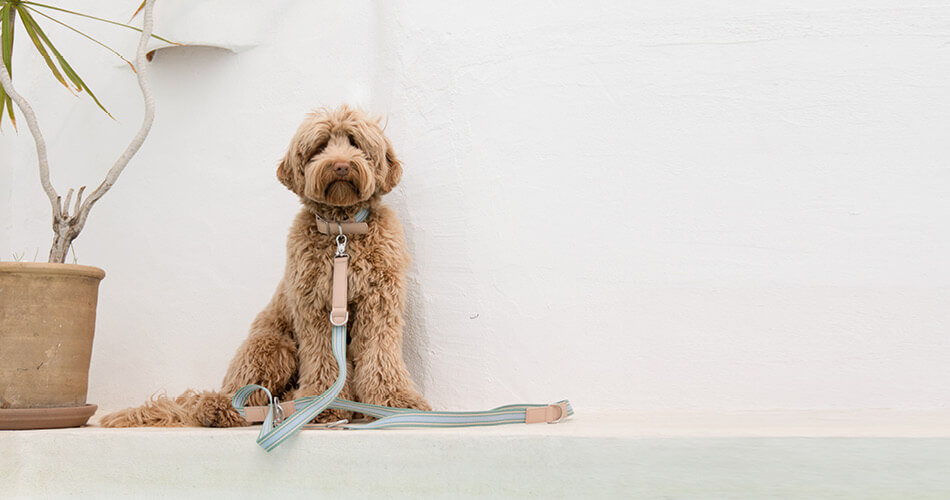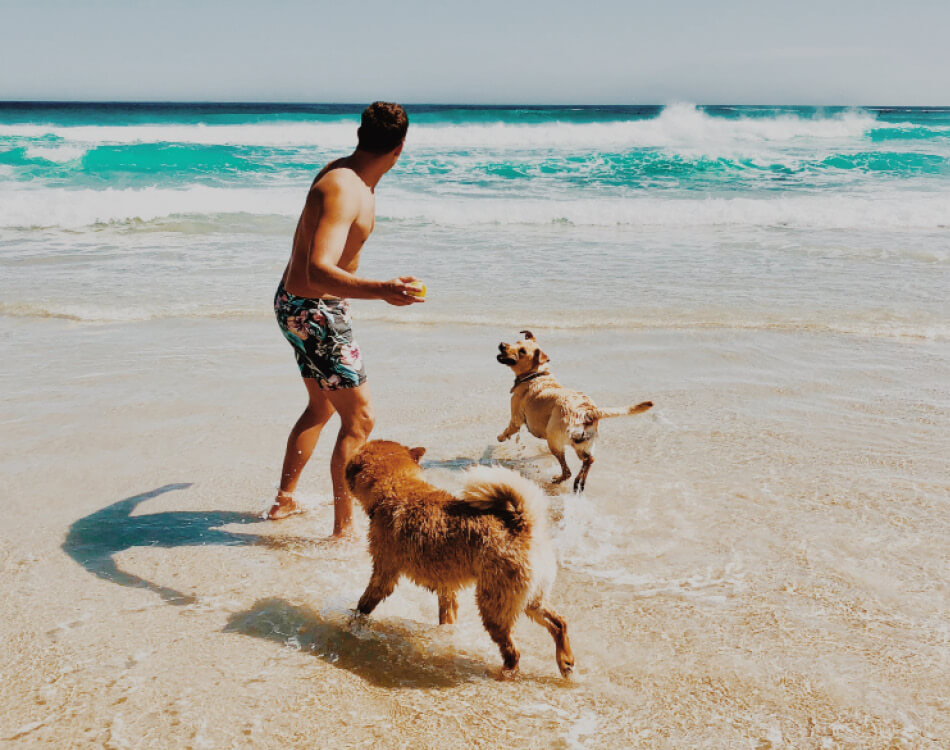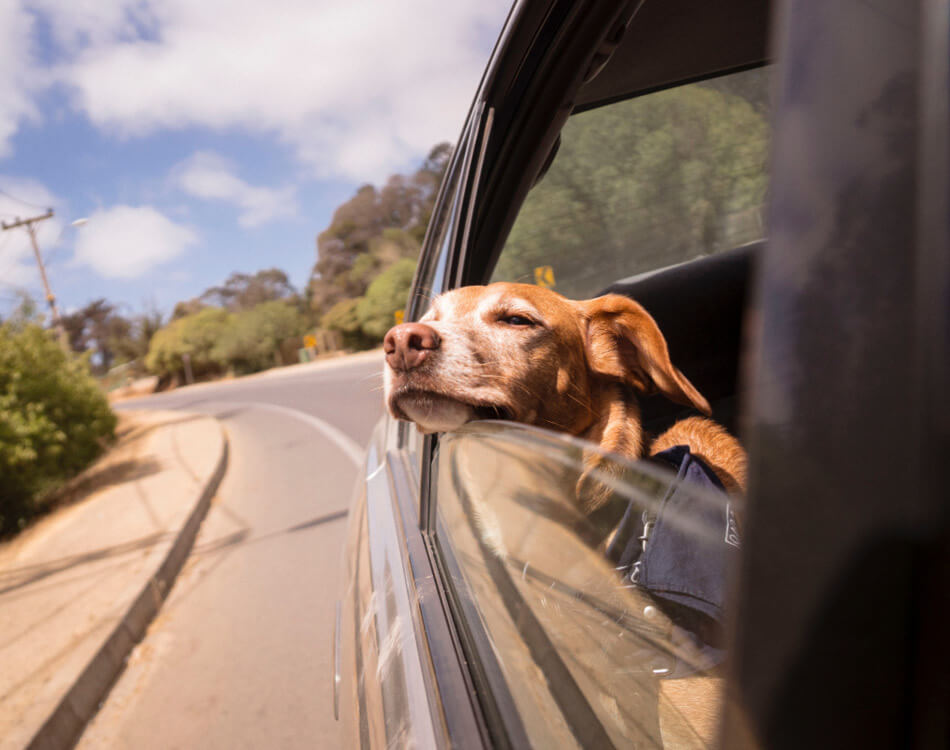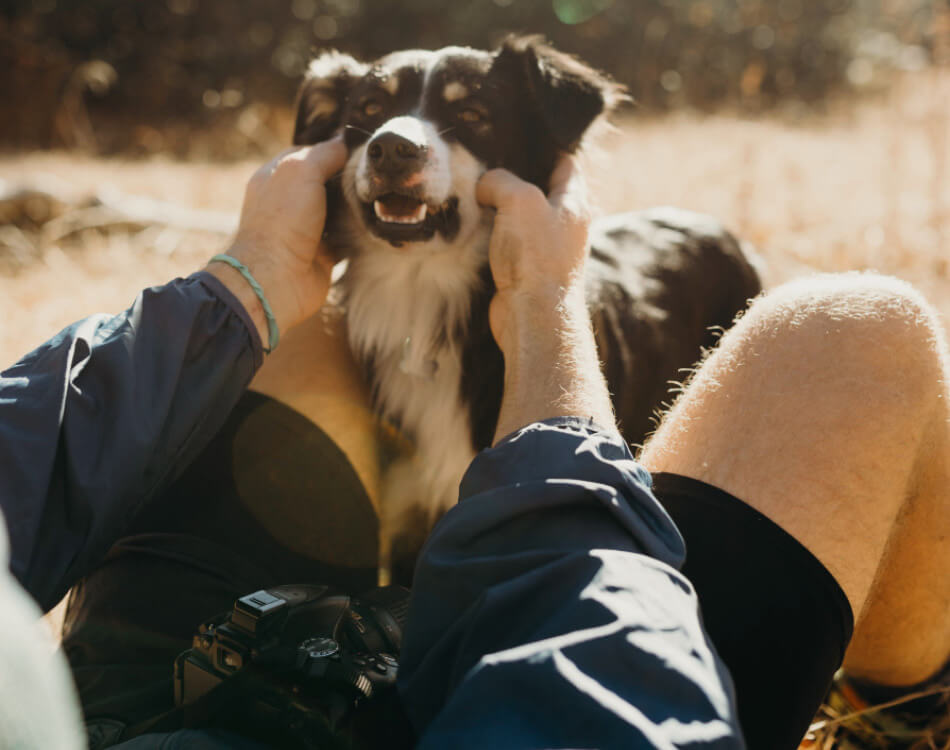Tip: Going on vacation with your dog, this is how you do it!

Vacation with your dog – the days are getting longer, and the sun is shining more often: summer is here again! It’s time to go out and about with your best friend. Whether you decide to stay close to home or go further away, you can still bring your furry companion along. If you need help deciding what to consider or how to prepare, don’t worry. In this article, you’ll find all the tips for a worry-free vacation with your dog!
Why Go on Vacation with Your Dog?
A vacation is the perfect opportunity to adventure with your furry companion. It’s time to create new memories and strengthen the bond between you! Moreover, a new environment is excellent for the socialization of your (young) dog. Everything in a new place is fascinating, distracting, or maybe a bit exciting for your furry friend. It’s the perfect place to train! New situations and unfamiliar smells offer numerous challenges for your dog; a little challenge is good for the brain! Plus, your dog is your best friend, a family member. You wouldn’t leave them behind, right?
Benefits of Going on Vacation with Your Dog Okay, we understand that bringing your dog on vacation also poses challenges. How do you transport your dog, and where will you accommodate them at the destination? What extra things must you bring, and what should you consider? We’ll address these issues shortly. First, let’s take a look at the benefits of bringing your dog on vacation:
Quality time:
You and your dog (and perhaps your family) get to spend time together and have the whole day for each other. This is the perfect opportunity to create a strong bond with your dog, so make the most of it!
Good socialization:
As mentioned earlier, a vacation means a new environment, new smells, and new people. This is great for the socialization and mental stimulation of your dog!
Training in a different place:
It’s great if your dog behaves well during training sessions and obediently repeats tricks at home. But does your dog still listen well when there are many distractions around? Training in a new place is essential to make your dog a flexible and well-behaved companion in any situation.
You retain the responsibility:
For many people, their dog is like their child. It’s nerve-wracking to leave them behind somewhere. No matter how great the boarding facility may seem or how lovely “grandma and grandpa” are, you still worry. When your dog comes with you on vacation, you retain the responsibility and see how well they do every day.
No hassle with boarding:
Dog kennels often fill up quickly, especially during vacation. Arranging good boarding can be a hassle. You may need to plan a year in advance, call kennels, and beg family and friends for help.
Save money:
Unless you can leave your dog(s) with your parents or friends, you’ll likely need to rely on boarding facilities and pet-friendly hotels. These can be pretty expensive, especially during school holidays.
It’s fun!:
This is, of course, the most important reason. In general, your dog will love exploring new areas with you. And there’s nothing more beautiful than seeing your dog happy and excited!
How do you take your dog on vacation?
Taking your dog on vacation requires more planning than just leaving spontaneously. You need to ensure that your destination is dog-friendly and that you have all the necessary items for your dog. It would help if you also practised with your dog beforehand, especially for long trips, to ensure that the journey itself is not too stressful. If you are well-prepared, going on vacation with your dog can be a lot of fun!
The journey
The first thing to consider is the mode of transportation for your vacation. Will you walk, cycle, drive, take the train, or fly? And how far will you be going? Depending on these factors, you must prepare your dog for the journey.
Walking & Cycling
A walking or cycling vacation is ideal for a dog, especially if you plan to travel through off-leash areas. If you have a walking or cycling vacation planned with your dog, start training early. Dogs cannot suddenly walk longer distances overnight. Additionally, walking alongside a bicycle is very strenuous for dogs. Even if they seem fine at the moment, they may experience discomfort later. Build up their stamina gradually by going on longer walks or bike rides. If you plan a long-distance trip, consider scheduling a practice weekend to train your dog for consecutive days of long walks or rides. Be mindful not to overexert young or older dogs. On hot days, walking alongside a bicycle can be too strenuous for dogs, so it’s better to go cycling only in the mornings and evenings. Always pay attention to the temperature of the asphalt on sunny days. It can heat up quickly. If you can’t place your hand flat on the asphalt, it can burn your dog’s paw pads!
Driving
The car is probably the best mode of transportation when you want to go on vacation with your dog. However, dogs need to learn how to ride in a car before they can go on a (long) journey! If your dog is immediately placed in the back of the car for hours, they can become car sick and stressed. Create a safe space, bring water, and take regular breaks.
Flying
Traveling by plane with a dog is possible but can be challenging to train and very stressful for many dogs. For larger dogs, a kennel in the cargo hold needs to be booked, while small dogs can often travel in a transport box as carry-on luggage. Contact your airline in advance to inquire about their specific policies. Check which vaccinations your dog needs to fly and practice sitting in a transport crate.
At the destination
Choose a destination where your dog is welcome and safe. This can be a dog-friendly hotel, vacation rental, or campground. Ensure that your dog has its own space, preferably with a bed, cushion, or blanket from home. Make sure there are enough shaded areas and that your dog cannot run away. Fortunately, many dog-friendly vacation rentals often have enclosed gardens. Ensure that your dog gets enough exercise but doesn’t overheat. Warm destinations like Southern Europe are less suitable for many dogs.
Things to Consider
Check in advance if your dog needs certain vaccinations before crossing the border. When booking a vacation spot, check for enough space, shade, and walking areas available. Before visiting a specific attraction, check if dogs are allowed. Your dog may prefer to stay “at home” rather than spend the whole day in a theme park’s kennel.
What not to forget on a vacation with your dog
- Dog passport: When crossing the border, you must bring your dog’s passport, including information about its vaccinations. Certain vaccinations are mandatory in some countries before bringing your dog across the border.
- Identification: Ensure that your dog has proper identification, including a collar with an ID tag with your contact information. It’s also a good idea to have your dog microchipped and ensure the microchip information is current.
- Food and Water: Pack enough food for your dog’s entire vacation and any necessary medications. Bring along your dog’s regular food to avoid digestive issues. Also, remember to bring collapsible bowls for food and water.
- Bedding and Comfort Items: Bring your dog’s bed or a familiar blanket to provide them with a comfortable sleeping space. Familiar scents can help ease anxiety in a new environment.
- Leashes and Harnesses: Pack a sturdy leash and a comfortable harness for your dog. Having control over your dog during walks and when exploring new places is essential.
- Toys and Chews: Bring your dog’s favourite toys and chews to keep them entertained during downtime. This will help prevent boredom and provide them with a sense of familiarity.
- First Aid Kit: Prepare a first aid kit specifically for your dog, including essentials such as bandages, antiseptic solution, tweezers (for removing ticks), and any necessary medications. Consult with your veterinarian for a complete list of recommended items.
- Poop Bags and Cleaning Supplies: Remember to pack poops bags to clean up after your dog. Additionally, bring some cleaning supplies, such as pet-friendly disinfectant wipes, in case of accidents or spills.
- Sunscreen for dogs: The nose, ears, thighs, and belly of dogs can get sunburned just like human skin. If you know that you will be spending a lot of time in the sun that day, apply particular sunscreen for dogs in those areas.
- Safety and Comfort During Travel: If you’re travelling by car, use a secure dog seatbelt, a crate, or a pet barrier to ensure your dog’s safety during the journey. Keep the temperature inside the car comfortable, and make regular stops for bathroom breaks and exercise.
- Veterinary Contact Information: Carry contact details for a local veterinarian or emergency veterinary clinic at your destination in case of any unexpected health issues.
- Patience and Flexibility: Traveling with a dog may require adjustments to your plans and routines. Be patient and flexible, allowing for breaks, rest, and adjustments based on your dog’s needs.
By preparing in advance and considering your dog’s specific needs, you can ensure a safe and enjoyable vacation for you and your furry friend.
- Research Pet-Friendly Accommodations: Before booking your accommodations, ensure they are pet-friendly and have the necessary amenities for your dog. Some hotels or vacation rentals may restrict dog size or breed, so it’s essential to check their pet policies in advance.
- Plan Dog-Friendly Activities: Look for activities and attractions at your destination that are dog-friendly. This could include hiking trails, beaches, parks, or outdoor cafes—research local dog parks or nearby areas where your dog can exercise and socialize with other dogs.
- Stick to a Routine: Dogs thrive on routine, so try to maintain a similar schedule to what they’re used to at home. Stick to regular feeding times, exercise routines, and bedtime rituals as much as possible. This consistency will help your dog feel more comfortable in a new environment.
- Be Mindful of Temperature: Depending on your vacation destination and the time of year, it’s crucial to be mindful of the temperature. Avoid leaving your dog in the car, as temperatures can rise quickly and become dangerous. Provide access to shade and fresh water to keep your dog cool and hydrated during outdoor activities.
- Stay Attentive to Your Dog’s Behavior: Pay close attention to your dog’s behavior during the trip. Changes in appetite, energy levels, or unusual behaviors can be signs of stress or discomfort. Make sure to provide plenty of reassurance, and if you notice persistent signs of distress, consider consulting a veterinarian.
- Respect Local Rules and Regulations: Be aware of any local rules or regulations regarding dogs. Some places may have leash laws, restrictions on dogs in certain areas, or specific waste disposal requirements. Always follow these guidelines to be a responsible pet owner and ensure a positive experience for everyone.
- Practice Good Etiquette: Remember to clean up after your dog and dispose of waste properly. Be considerate of other travelers and respect their space. Keep your dog on a leash unless in designated off-leash areas, and always ask for permission before allowing your dog to approach other people or dogs.
- Enjoy Quality Time Together: Remember that your vacation is not just about the destination but also about spending quality time with your dog. Take walks, explore new places together, and engage in activities you enjoy. This will strengthen the bond between you and create lasting memories.
- Relax and Be Flexible: While planning and preparing is essential, it’s also important to be flexible and adaptable during your vacation. Things may not always go as planned, and that’s okay. Embrace the unexpected, go with the flow, and enjoy the journey with your dog.
5 bonus tips:
- Trim your dog beforehand and bring a brush: By brushing your dog, they will shed their undercoat and can better regulate their body heat. This is especially beneficial on hot summer days. Many dogs also benefit from a good grooming session before a vacation, especially if you’re heading to a sunny destination.
- Adapt your vacation to your dog: Going on vacation with your dog is a lot of fun and, as mentioned, has many advantages. However, it will only be enjoyable for your dog if you are willing to adjust your vacation plans to accommodate them. Leaving a dog alone in a caravan or making them walk through a scorching city centre on a hot day is not enjoyable for them. Instead, spend much time in nature with your dog and engage in active activities, especially in the mornings and evenings. Remember that puppies, older dogs, overweight dogs, dogs with thick or dark coats, and dogs with short muzzles (such as pugs, bulldogs, boxers, etc.) have a more challenging time dissipating heat and are more prone to overheating. Limit physical exertion for these dogs.
- Prevent overheating: Overheating can be life-threatening for dogs. Avoid strenuous activity during the midday heat, allow your dog to swim in warm weather (after teaching them how to swim), and create plenty of shaded areas at your vacation destination. A tent area with shade is suitable for a dog. Additionally, various products available nowadays can help keep your furry friend cool in the summer, such as cooling mats, cooling collars, or special cooling jackets. If your dog is lethargic, panting heavily, and feels warm to the touch, it might be overheating. Drooling or vomiting are further signs. In that case, gradually cool your dog down in the shade by wetting them or covering the hairless areas (belly, paw pads) with a wet towel. Do not use cold water or cover the entire dog, as it will prevent heat dissipation. Provide your dog with lukewarm water to drink. If you have any doubts, don’t hesitate to contact a veterinarian.
- Purchase a sturdy harness for your dog: Even if your dog usually walks with a collar, it might be wise to invest in a good harness for the vacation. This will allow you to secure your dog more safely in the car and give them more freedom of movement when attached to a leash. A harness also provides better support for your dog while swimming. However, make sure to introduce your dog to the harness gradually.
- Be cautious with stagnant water: Swimming with your dog during vacation is fun. However, most ponds and lakes can become sources of blue-green algae and botulism during the summer, both dangerous bacteria with severe consequences. Always check if the water is safe before letting your dog swim. Recreational areas where humans are also welcome are usually monitored regularly. If in doubt, choose flowing water for swimming.
Following these additional tips will prepare you to have a fantastic vacation with your dog. Enjoy your trip and create wonderful memories together!
Sources: MedPets.nl




